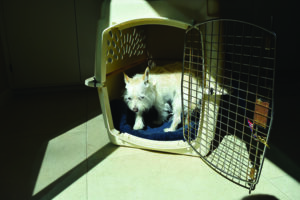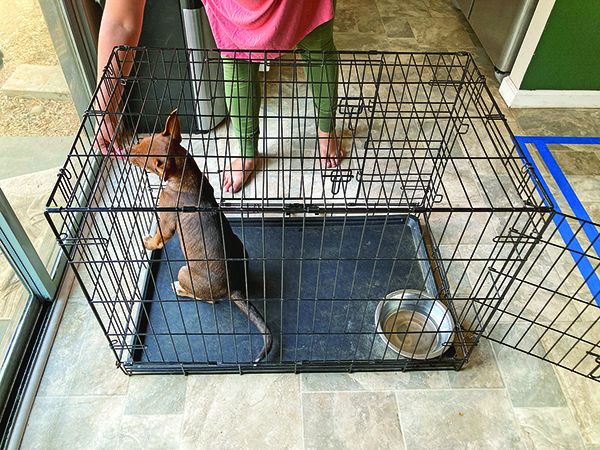Having a dog who enjoys time in a crate is a beautiful thing. A crate can give a dog some peace and quiet when the house is abuzz with overwhelming activity. It can help keep a young dog out of trouble when you’re not able to supervise his activity. And often, dogs must be crated for their own safety when recovering from an injury or surgery, or during an emergency evacuation.
Even the most contented crate-trained dog can hit a snag, though, and make him feel that the crate is no longer great. Maybe your dog caught his foot on the way out. Maybe he hit the door and startled himself on the way in. Maybe the family decided to let him sleep loose for a few days and now he’s balking at the idea of returning to the crate. Whatever the reason, the following tips can help a dog return to cooperative crating:
*Treat party! While most people initially toss treats into the crate in the early stages of crate training, once the dog willingly runs into the crate, often, the treats stop. For some dogs, a simple return to tossing a couple of treats into the crate can improve how the dog feels about the situation. Consistent “crate cookies” are a nice way to say, “Thank you!” when your dog enters the crate at your request.
*Meals in the crate. Feeding meals in the crate can also help rebuild a positive association with crating. Start with the food bowl just inside the crate; it’s okay if your dog only has her head inside the crate and the rest of her body is outside – she’s still partially in the crate! Over a few days, gradually move the food bowl deeper inside the crate.
Be sure to secure the crate door so it won’t move and potentially startle your dog as she negotiates the threshold during a meal; a bungee cord works well.
Resist the temptation of closing the crate door as soon as your dog fully enters the crate. Using treats or a meal to entice the dog into the crate and then closing the door isn’t training – it’s a trap! Early training sessions should give a dog the choice to decline entry (which suggests we need to make the behavior easier) or to freely exit.
If after a few days of open-door meals in the crate, your dog appears to have recovered from his newfound crate avoidance, it’s likely safe to close the door. If the dog continues eating with the door closed, you may have solved the problem.
Continue feeding meals in the crate at least a few days each week and offer delicious “crate cookies” every time. Also, make a point to ask your dog to “Crate up!” or “Go to bed!” for varying amounts of time throughout the day and not just at night for sleeping or when you need to leave the house for an extended period of time.
If your dog stops eating as soon as he realizes the crate door is closed, you’ll want to progress a little slower. Steps might include:
*Build duration. Once your dog willingly enters the crate for a tossed cookie or bowl of food, position yourself at the side of the crate and be ready with treats to feed through the bars, delivered at the back end of the crate.
*Offer a steady stream of treats and praise as long as the dog remains in the crate. If the dog exits the crate, the treats stop. Give him time to think. When he re-enters the crate, resume the cookie stream. A loaded snuffle mat can also work to keep the dog happily occupied inside the crate for longer periods of time.

*Dogs are creatures of habit. If you’ve taken the time to crate train your puppy or dog, retain this valuable skill. Preventing crate problems is easier than fixing them.
*Some dogs grow leery of the crate when its only used for long periods at night or when leaving the dog home alone. Make crating a regular part of your dog’s life by asking him to “Crate up!” or “Go to bed!” randomly throughout the day, and for varying lengths of time (including some that are quite brief!).
*Consistently reward entering the crate and occasionally feeding meals in the crate to help maintain your dog’s cooperation with crating.
*Crate-training sessions should include the option to leave the crate – otherwise you risk the dog feeling trapped, which can make him even more leery of the crate AND of you and your offered cookies.
*Avoid using the crate as punishment. Even if you’re using the crate to contain the dog as you clean up a mess he made, keep your cool and offer a “crate cookie” as you direct him into the crate.
*Desensitize to the door. For some dogs, closing the door is the trigger for unhappy feelings, either because they associate the crate with long periods of isolation or because they’ve been spooked by the door at some point. Pair closing the door with the delivery of treats; this can help change how the dog feels through a process called counter-conditioning.
Toss a treat into the crate. As the dog enters the crate, position yourself at the open end of the crate and be ready with treats. As soon as the dog turns around, toss a few treats at his feet. When he eats the treats and looks at you expectantly, toss a few more. When he looks at you the next time, gently move the door back and forth a couple of inches – and then toss treats into the crate.
*Practice daily, and be generous! Repeat this process over a few days, gradually adding more door movement as you work up to fully closing the door and tossing treats through the bars. This should look so easy for your dog that you’ll wonder why you’re even doing it. Don’t skimp here. Even if your dog isn’t triggered by the door, this process still helps build value for being in the crate.
If your dog continues to struggle, or is so avoidant she won’t even go near the crate, we recommend working with a positive-reinforcement trainer who can develop a training plan specific to your dog’s needs.






All of my dogs go into their crates easily, however one of then barks almost incessantly. How can i address that?